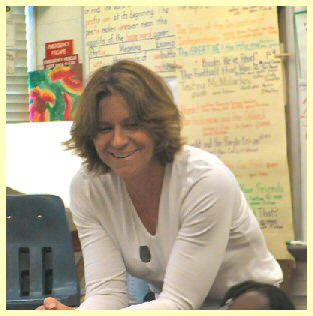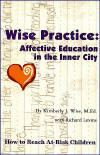|
Introduction by Author
Kimberly Wise

It is the last day of school. Michael comes to say goodbye for the summer. He is small for
his nine years, and like most of our students, African American. I don’t know if I’ll ever see him
again.
I
teach in a core city school, in Jacksonville, Florida. The children often don’t have a home the
way I knew home to be. Rather it’s, “I stay at,” followed by an assortment of relatives and
relations, usually mother, occasionally mother and father, but nearly as often an aunt or
grandmother. No more than 40 percent of our students return every year. Drug dealing,
prostitution and welfare underpin the local economy. News of a third grader raped on her way
home from school caused no more reaction than an approaching thunderstorm.
I lightly knead his head.
“Are you coming back next year?”
Michael shrugs. He lives in a homeless shelter with his mother. Next year might as well be
the next century.
“Thank you, Ms. Wise, for teaching me this year.”
“What did you learn?”
Michael speaks slowly, as if putting thought into every syllable.
“How to have peace. How not to have anger and stuff. How to shake right, eye contact
when you talk, and put your chin up, don’t have your face down.”
“Have you used what you’ve learned outside of school?”
He thinks for a moment.
“About two days ago somebody hit me,” he hits his fist into his palm. “I was going to turn
around and do the bad stuff, but I just calmed down, turned around and walked outside.”
“How did you feel afterward?”
“I felt good about myself because I didn’t do nothing bad.”
Invariably,
people point to poverty as the primary cause of crime. It has become an axiom.
I disagree. For over ten years, I’ve been part of a team teaching urban
children peace. Wisdom has to be taught, and anyone can learn it. Regardless
of family financial circumstances, children respond to respect. I feel
confident in saying a child in a homeless shelter with an affectionate, loving
mother is infinitely better off than one with emotionally detached or violent
parents in the biggest mansion. Likewise, the effect of a wise and nurturing
teacher far exceeds any benefits conferred by high-priced buildings or
equipment.
- Students reflect the attitudes and behavior they see at home and school. The way to change
harmful habits is to provide an attractive alternative. Teaching the skills and knowledge basic to
make one’s self feel good is such an alternative. Feeling safe, feeling good, releases endorphin, a
stress reliever. Teaching children how to respect themselves and others propels a psychological and
physiological cascade of habitual emotional health. We have taught so called “at-risk” children
these relationship skills, then watched them blossom.
-
- The system, however, operates on an underlying belief that children need to be adequately
stressed to become good people. We teach morals by lecturing, shaming and punishing. Yet
research shows this doesn’t work. Fear causes the release of the stress hormone, cortisol, and its
release causes more fear, resulting in chronic stress. Disrespect underlies the endemic bullying and
stress in our public schools. But instead of inoculating our children with the vaccine of respect, we
reinforce the disease with threats and shame.
-
- Harsh correction, accusation, and embarrassment doesn’t build character. Instead, it floods
already stressed young bodies with stress hormones. If you want them to do better, you help them
feel better. Yet we try to solve a problem caused by attacks on dignity and self-worth by attacking
dignity and self-worth.
-
- My first education class delineated education into the affective and cognitive domains.
Affect is the conscious aspect of feeling or emotion, and its influence on behavior. That was my
only exposure to affective instruction in undergraduate school, the next four years focused only on
cognitive learning. America has neglected affective education. Affective education takes time and
repetition. To learn respect, children need to experience respect. Instead of reacting by
commanding and dominating, teachers can show how to respond by questioning and listening. The
children then learn how to respect themselves, to release their own “feel good” chemicals at will.
-
- Many
of our children were considered incorrigible. Yet once they learned how to
relieve their young bodies from the burden of chronic stress hormones,
cognitive learning skyrocketed. The strategies may be simple, but they won’t
work without changing the way we think about teaching. Affective education is
what is needed to reverse the epidemic of disrespect and violence, everywhere.
|


